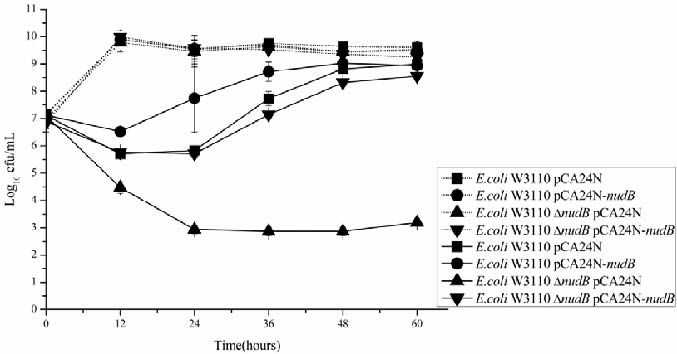Scientists find that deletion of nudB causes increased susceptibility to antifolates in Escherichia coli and Salmonella enterica
Date:05-04-2017 | 【Print】 【close】
Co-trimoxazole, a fixed-dose combination of sulfamethoxazole (SMX) and trimethoprim (TMP), has been used for the treatment of bacterial infections since the 1960s.
Since it has long been assumed that the synergistic effects between SMX and TMP are the consequence of targeting 2 different enzymes of bacterial folate biosynthesis, 2 genes (pabB and nudB) involved in the folate biosynthesis of Escherichia coli were deleted, and their effects on the susceptibility to antifolates were tested by the reseach group led by Prof. Jiaoyu Deng in WIV, under the collaboration with Prof. Xian’en Zhang from Institute of Biophysics. The results showed that the deletion of nudB resulted in a lag of growth in minimal medium, and increased susceptibility to both SMX and TMP. Moreover, deletion of nudB also greatly enhanced the bactericidal effect of TMP. To elucidate the mechanism of how the deletion of nudB affects the bacterial growth and susceptibility to antifolates, 7, 8-dihydroneopterin and 7, 8-dihydropteroate were supplemented into the growth medium. Although those metabolites could restore bacterial growth, they had no effect on the susceptibility to the antifolates. Reverse mutants of the nudB deletion strain were isolated to further study the mechanism of how the deletion of nudB affects the susceptibility to antifolates. Targeted sequencing and subsequent genetic studies revealed that the disruption of the tetrahydromonapterin biosynthesis pathway could reverse the phenotype caused by the nudB deletion. Meanwhile, overexpression of folM could also lead to increased susceptibility to both SMX and TMP. These data suggested that the deletion of nudB resulted in the excess production of tetrahydromonapterin, which then caused the increased susceptibility to antifolates. In addition, they found that the deletion of nudB also resulted in the increased susceptibility to both SMX and TMP in Salmonella enterica Since dihydroneopterin triphosphate hydrolase is an important component of bacterial folate biosynthesis and the tetrahydromonapterin biosynthesis pathway also exists in a variety of bacteria, it will be interesting to design new compounds targeting dihydroneopterin triphosphate hydrolase, which may inhibit bacterial growth and simultaneously potentiate antimicrobial activities of antifolates targeting other components of folate biosynthesis.

Time-kill curves of different E. coli strains after exposure to 2 μg/mL of TMP.
Data represent mean ± SD from 3 independent experiments. Image by Jiaoyu Deng
Contact: